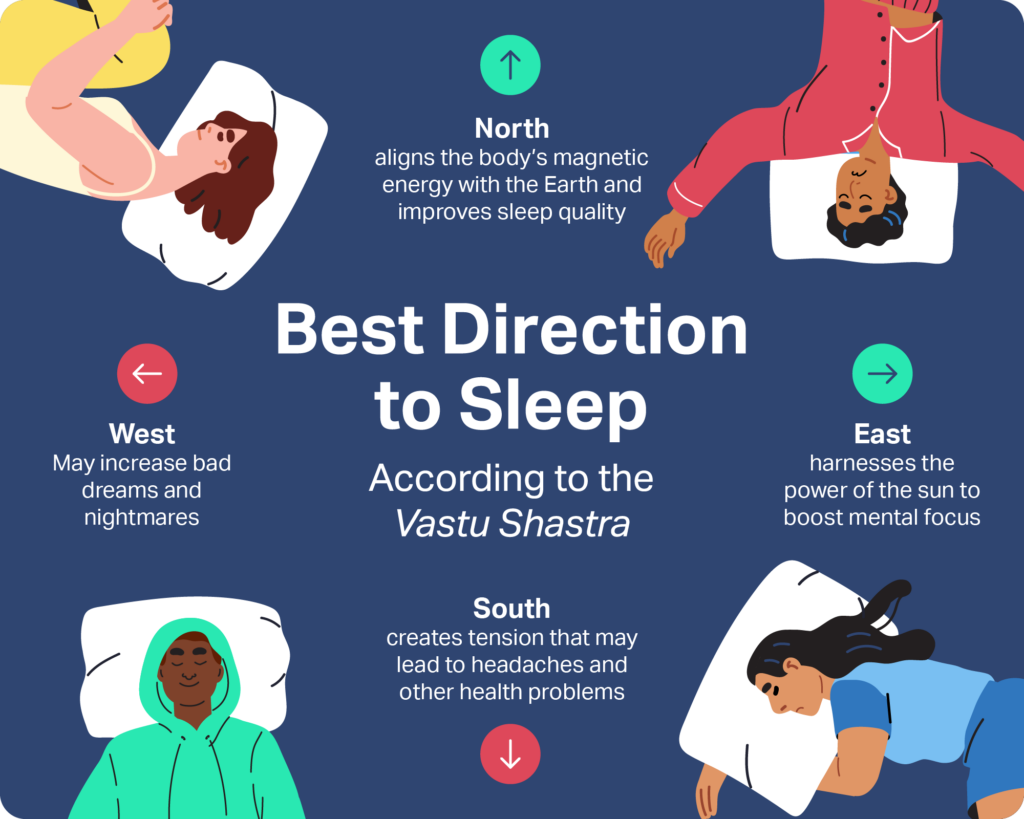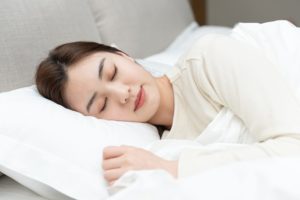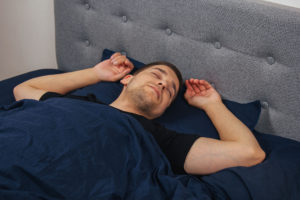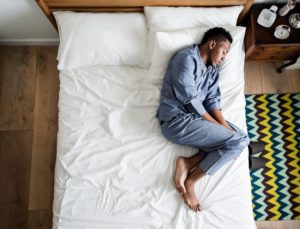When you buy through our links, we may earn a commission. Products or services may be offered by an affiliated entity. Learn more.
Which Direction is Best to Sleep in?
- South is considered the best direction to sleep, according to ancient Vastu Shastra tradition and observations of nature.
- When your head is towards the south it aligns with the earth’s electromagnetic field.
- One early scientific study indicated that sleeping toward the south may improve sleep.
- The practice of feng shui may also promote more positive energy in your bedroom.
There is an art to designing the best bedroom environment for sleep. You can dim the lights, repaint your walls a calming hue, and splurge on comfortable bedding.
Eastern medicine and spiritual practices suggest there may be even more you can do — all the way down to adjusting the direction you sleep in.
Which Direction Is Best to Sleep in?
According to ancient traditions like Vastu Shastra, the best direction to sleep in is toward the south. This theory is also supported by some recent research . This means that when you lie in bed, your head is pointed south , and your feet are pointed north.

Is Your Troubled Sleep a Health Risk?
A variety of issues can cause problems sleeping. Answer three questions to understand if it’s a concern you should worry about.
Why Is South the Best Sleeping Direction?
Some research has found that animals, such as cattle and deer , naturally align their bodies in a north-south direction when they are eating or resting. Additionally, preliminary research shows that when people switch to sleeping in a southward-facing direction, their blood pressure lowers and their sleep quality improves.
The Earth’s electromagnetic field may offer an explanation for this, according to some research and Vastu Shastra.
What is Vastu Shatsra?
Vastu Shastra is an ancient architectural tradition that hails from India. Practitioners view buildings as living organisms that can be designed in harmony with the energy of the universe. The concept leans on Hindu mythology and beliefs, such as the human body having its own north and south poles, similar to the Earth.
according to Vastu Shastra, you line up your body’s magnetic energy with that of the Earth. Your “north pole,” or your head, is oriented towards the Earth’s south pole, so opposite poles can attract. When you lie the other way, you have two similar poles facing each other, which practitioners believe may contribute to headaches and high blood pressure.
While there is no research connecting headaches and sleep direction, there is some evidence that sleeping toward the south may reduce your risk of high blood pressure. One study compared people who slept in an east-west direction versus north-south direction. After a period of three months, those who slept in the north-south orientation had lower blood pressure, better sleep quality, and longer sleep overall. It has been shown that the duration of deep sleep was increased by north-south sleepers while shortened in east-west sleepers. As a result, the researchers concluded that sleeping in alignment with the Earth’s electromagnetic field could improve sleep quality.
A recent study showed alterations in the participants’ brain waves when they were exposed to manipulated electromagnetic fields , suggesting that humans may be sensitive to the Earth’s magnetic energy. However, older studies that have exposed people to magnetic fields during sleep have found that it had no effect on their sleep quality , so more research is still needed in this area.
However, it is important to note that this general rule of sleep with the head facing towards the south applies if you live in the Northern hemisphere. If you live in the Southern hemisphere, the opposite would apply given the polarity rule, where the optimal direction for the head of the bed is actually the north side.

Is It Bad to Sleep in Other Directions?
Because your head functions like a north pole, sleeping with your body in a north-facing position is considered a worst-case scenario, according to Vastu Shastra. It creates tension that may lead to headaches and other health problems. To achieve balance, your head should point southward while you sleep, in line with the Earth’s electromagnetic pull. Ideally, your entire bedroom would be oriented south as well.
Some research has shown that those who sleep in the north-south position also take longer to enter rapid eye movement (REM) sleep, an essential stage of sleep for cognitive functioning, emotional well-being, and overall health. In this study, those who slept in an east-west position entered REM sleep earlier. However, other research has shown that those who sleep east-west get less sleep overall. Until more research is done, the pros and cons of the east-west sleeping orientation may cancel each other out.
Other Principles from Eastern Medicine for Sleep
Sleeping orientation is just one Eastern medicine principle designed to promote sleep. Vastu Shastra offers many others, as does the Chinese practice of feng shui. Feng shui focuses on promoting the flow of positive energy, or chi , in your environment through the thoughtful placement and orientation of objects. For example, in the bedroom, practitioners may replace a desk with a loveseat to improve their love life , or move their bed against the wall for better chi.
While their particulars may vary, both feng shui and Vastu Shastra share a focus on energetic balance and the importance of designing your space to promote health and well-being.
If you are interested in other ways to improve your sleep and the design of your bedroom, you may want to consider some additional recommendations from feng shui and Vastu Shastra.
Place Your Bed in a Harmonious Position
According to the principles of feng shui, you should place your bed directly against a wall, but not underneath any windows. Ideally, it should be placed on the wall opposite to your bedroom door, in a spot where you can see the door clearly but are not directly in line with it. This is said to put you in the “ command position ,” which makes you feel empowered and in control.
If your bed does not fit on that opposite wall, you can add a mirror to the room so you can see the door and maintain that sense of control. However, do not place the mirror facing the bed as this may amplify energy that can disrupt sleep.
Also, do not sleep with your feet pointed toward the door. This so-called “coffin position” is considered an unlucky sleep position in feng shui, since it mimics the way a person’s corpse is carried out of a room when a person dies.
Remove Clutter and Electronics
Proponents of feng shui also say that clutter can mess with your chi. Clear clutter, and you’ll have more space for good energy to enter. Some research suggests that when we observe more distance between objects, it improves our emotional state .
As with Vastu Shastra, many feng shui practitioners worry about the effects of electromagnetic fields, which may be an incentive to keep electronics out of the bedroom. Removing electronics from the bedroom is also one of the core tenets of good sleep hygiene, a set of habits that is designed to promote better sleep.
Promote Good Energy in Your Bedroom Design
Feng shui says objects like curtains, artwork, and plants can capture negative energy, known as “sha chi,” and transform it into good chi. Plants in particular can add a calming energy to your bedroom and help relieve stress.
Couples who share a bedroom may want to take an additional step to remove anything that is not related to their relationship, like a desk or a work computer. Additionally, couples may consider adjusting the placement of certain items to direct all the positive chi toward helping their relationship flourish and thrive.
Repaint Your Bedroom
Both feng shui and Vastu Shastra recommend certain color schemes for different directions to promote particular energies. Feng shui, for example, draws associations between the following colors and cardinal points:
- Green with the east, for creation and growth
- White or gray with the west, for money
- Red with the south, for power
- Black with north, for communication
One way to achieve an energetic boost toward one of these goals might be to paint the accent wall in that direction with the corresponding color.
Vastu Shastra takes a slightly different approach, instead recommending that a person select a color scheme based on their personality. Vastu Shastra believes that each person has more or less of the natural elements, which are called “doshas”:
- Those with vata dosha (air) should use green and yellows
- Those with pitta dosha (fire and water) should paint with blues and greens
- Those with kapha dosha (earth and water) should select reds and violets
Many of these recommendations stem from ancient practices. They remain popular today, although there is not always a wealth of scientific research backing them up. Still, there is no harm in trying a different sleep direction, and seeing how it makes you feel.

Still have questions? Ask our community!
Join our Sleep Care Community — a trusted hub of sleep health professionals, product specialists, and people just like you. Whether you need expert sleep advice for your insomnia or you’re searching for the perfect mattress, we’ve got you covered. Get personalized guidance from the experts who know sleep best.
References
11 Sources
-
Hekmatmanesh, A., Banaei, M., Sadeghniiat-Haghighi, K., & Najafi, A. (2019). Bedroom design orientation and sleep electroencephalography signals. Sleep Medicine, 6(1), 33-37.
https://www.actamedicainternational.com/article.asp?aulast=Hekmatmanesh;epage=37;issn=2349-0578;issue=1;spage=33;volume=6;year=2019 -
Saran, S., & Shirodkar, A. D. (2017). Vastu shastra and feng shui: The ancient sciences and their fusion in the context of Indian architecture. International Journal of Scientific & Technology Research, 6(11), 136–144.
http://www.ijstr.org/final-print/nov2017/Vastu-Shastra-And-Feng-Shui-The-Ancient-Sciences-And-Their-Fusion-In-Context-Of-Indian-Architecture.pdf -
Begall, S., Cerveny, J., Neef, J., Vojtech, O., & Burda, H. (2008). Magnetic alignment in grazing and resting cattle and deer. Proceedings of the National Academy of Sciences of the United States of America, 105(36), 13451–13455.
https://pubmed.ncbi.nlm.nih.gov/18725629/ -
Wang, C. X., Hilburn, I. A., Wu, D. A., Mizuhara, Y., Cousté, C. P., Abrahams, J., Bernstein, S. E., Matani, A., Shimojo, S., & Kirschvink, J. L. (2019). Transduction of the geomagnetic field as evidenced from alpha-band activity in the human brain. eNeuro, 6(2), ENEURO.0483-18.2019.
https://pubmed.ncbi.nlm.nih.gov/31028046/ -
Tworoger, S. S., Davis, S., Emerson, S. S., Mirick, D. K., Lentz, M. J., & McTiernan, A. (2004). Effect of a nighttime magnetic field exposure on sleep patterns in young women. American Journal of Epidemiology, 160(3), 224–229.
https://pubmed.ncbi.nlm.nih.gov/15257995/ -
Ruhenstroth-Bauer, G., Günther, W., Hantschk, I., Klages, U., Kugler, J., & Peters, J. (1993). Influence of the earth’s magnetic field on resting and activated EEG mapping in normal subjects. The International Journal of Neuroscience, 73(3-4), 195–201.
https://pubmed.ncbi.nlm.nih.gov/8169054/ -
Bonaiuto, M., Bilotta, E., & Stolfa, A. (2010). “Feng shui” and environmental psychology: A critical comparison. Journal of Architectural and Planning Research, 27(1), 23-34.
http://www.jstor.org/stable/43030890 -
Lupone, L. (1999). Feng shui: Therapy for the new millennium. Complementary Health Practice Review, 5(2), 115–120.
https://journals.sagepub.com/doi/abs/10.1177/153321019900500201 -
Margolies, J. (2020, September 29). Feng shui lessons from a design master who has your back. The New York Times., Retrieved August 6, 2021, from
https://www.nytimes.com/2020/09/29/style/fengshui-interior-design-lesson.html -
Williams, L. E., & Bargh, J. A. (2008). Keeping one’s distance: the influence of spatial distance cues on affect and evaluation. Psychological Science, 19(3), 302–308.
https://pubmed.ncbi.nlm.nih.gov/18315805/ -
Irish, L. A., Kline, C. E., Gunn, H. E., Buysse, D. J., & Hall, M. H. (2015). The role of sleep hygiene in promoting public health: A review of empirical evidence. Sleep Medicine Reviews, 22, 23–36.
https://pubmed.ncbi.nlm.nih.gov/25454674/















